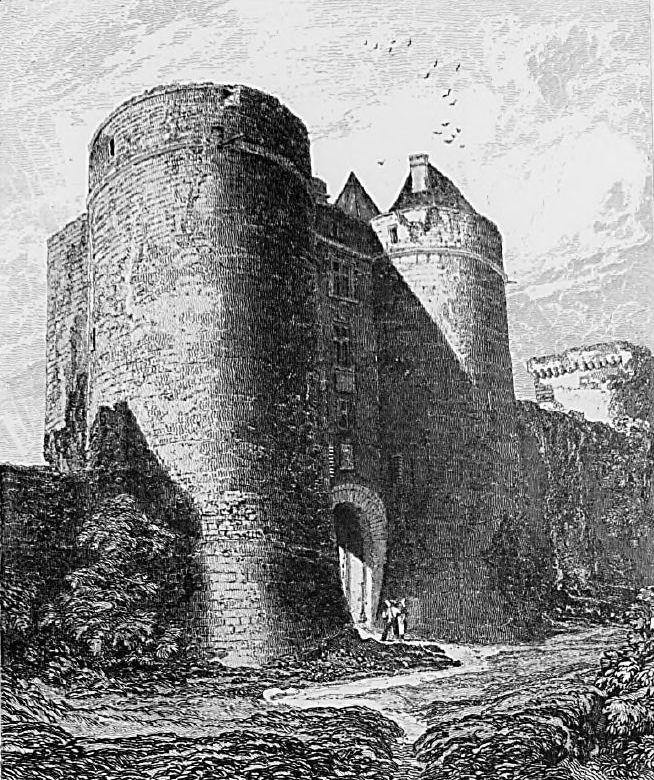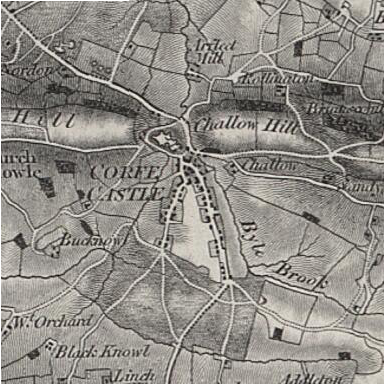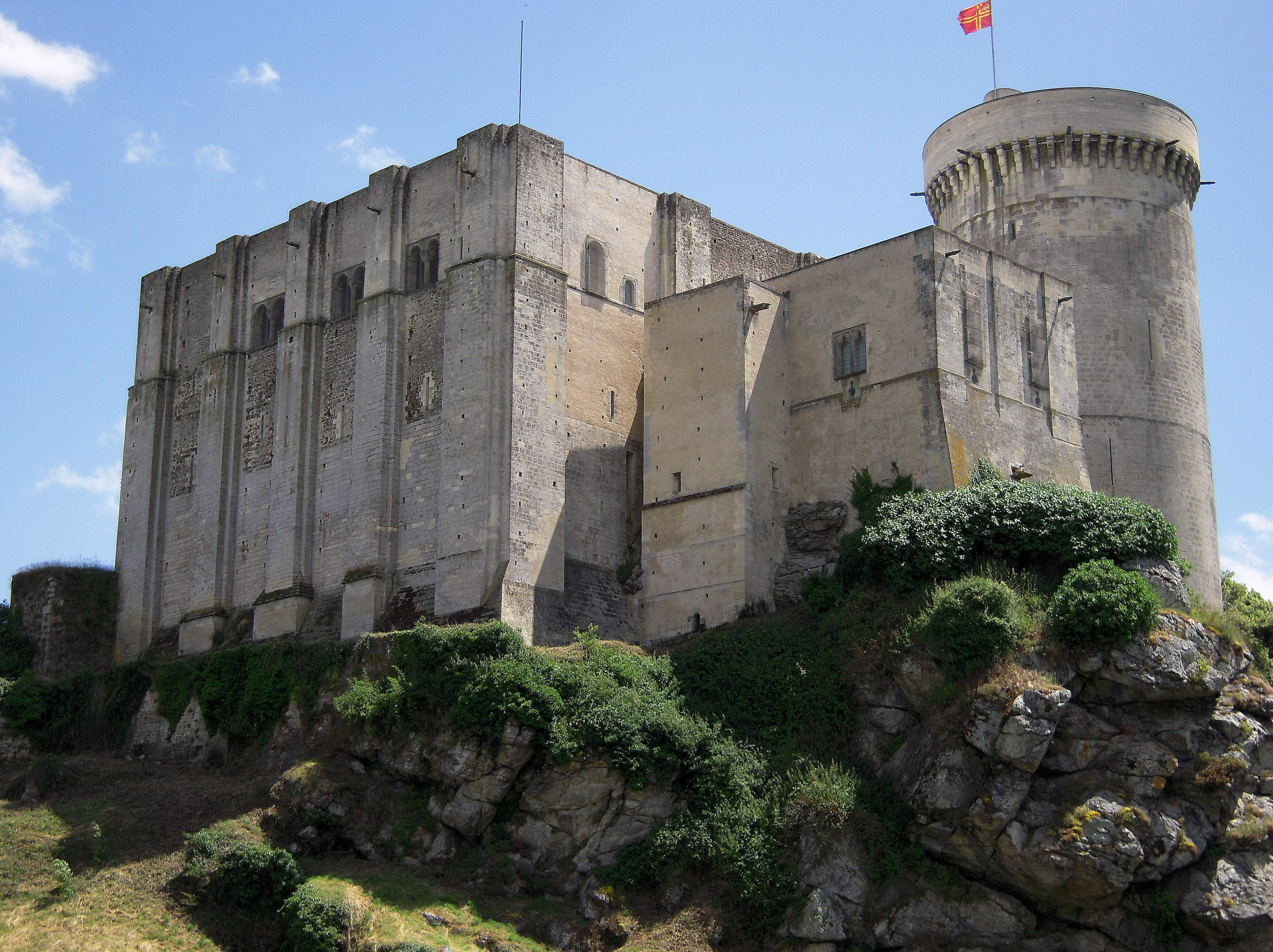|
Alix Of Thouars
Alix of Thouars (1200 – 21 October 1221) (in Breton Alis) ruled as Duchess of Brittany from 1203 until her death. She was also Countess of Richmond in the peerage of England. Life Alix was born in 1200. She was the daughter of Constance, Duchess of Brittany and Guy of Thouars. According to several French historians, Constance died after giving birth to Alix's sisters Catherine and Margaret. Alix's older half-brother was Arthur I, Duke of Brittany and her half-sisters were Eleanor, Fair Maid of Brittany and Matilda of Brittany, the children of Constance and Geoffrey Plantagenet. Upon the death of Richard I of England, a power struggle commenced between her half-brother Arthur and John, King of England. At the Battle of Mirebeau in 1202, Arthur and Eleanor were captured. Arthur was imprisoned at the Château de Falaise and in 1203 disappeared. Eleanor was imprisoned at Corfe Castle. The Breton barons recognized Alix as Duchess of Brittany after the presumed death of A ... [...More Info...] [...Related Items...] OR: [Wikipedia] [Google] [Baidu] |
Chartres Cathedral
Chartres Cathedral, also known as the Cathedral of Our Lady of Chartres (french: Cathédrale Notre-Dame de Chartres), is a Roman Catholic church in Chartres, France, about southwest of Paris, and is the seat of the Bishop of Chartres. Mostly constructed between 1194 and 1220, it stands on the site of at least five cathedrals that have occupied the site since the Diocese of Chartres was formed as an episcopal see in the 4th century. It is in the High Gothic and Romanesque styles, with a Flamboyant north spire. The cathedral was designated a World Heritage Site by UNESCO in 1979, which called it "the high point of French Gothic art" and a "masterpiece". The cathedral is well-preserved and well-restored: the majority of the original stained glass windows survive intact, while the architecture has seen only minor changes since the early 13th century. The building's exterior is dominated by heavy flying buttresses which allowed the architects to increase the window size si ... [...More Info...] [...Related Items...] OR: [Wikipedia] [Google] [Baidu] |
French Historians
This is a list of French historians limited to those with a biographical entry in either English or French Wikipedia. Major chroniclers, annalists, philosophers, or other writers are included, if they have important historical output. Names are listed alphabetically by last name in each section, except for the section, where they are ordered by date of birth. Introduction History only matured as a serious academic profession in the 19th century. Before that, it was exercised as a literary pursuit by amateurs such as Voltaire, Jules Michelet, and François Guizot. The transition to an academic discipline first occurred in Germany under historian Leopold von Ranke who began offering his university seminar in history in 1833. Similar introduction of the discipline into academia in France took place in the 1860s. Historians active in France at the time such as who were active at that time inherited the principles of a new academic discipline from Ranke and earlier mentors including ... [...More Info...] [...Related Items...] OR: [Wikipedia] [Google] [Baidu] |
Counts And Dukes Of Angoulême
Angoulême (''L' Angoumois'') in western France was part of the Carolingian Empire as the kingdom of Aquitaine. Under Charlemagne's successors, the local Count of Angoulême was independent and was not united with the French crown until 1308. By the terms of the Treaty of Brétigny (1360) the Angoumois, then ruled by the Counts of Angoulême, was ceded as English territory to Edward III. In 1371 it became a fief of the Duke of Berry, before passing to Louis I, Duke of Orleans, both of whom were cadets of the French royal family. From then on it was held by cadets of the Valois House of Orleans, until Francis, Count of Angoulême, became King of France in 1515. Angoumois was definitively incorporated into the French crown lands, as a duchy. Counts of Angoulême House of Guilhelmides (Williami) *Turpio (839–863) * Emenon of Poitiers (863–866), brother of Turpio ** Aymer of Poitiers (Aymer I of Angoulême) (916-926), son of Emenon House of Taillefer * Wulgrin I (866–886), ... [...More Info...] [...Related Items...] OR: [Wikipedia] [Google] [Baidu] |
Hugh XI Of Lusignan
Hugh XI de Lusignan, Hugh VI of La Marche or Hugh II of Angoulême (1221 – 6 April 1250) was a 13th-century French nobleman. He succeeded his mother Isabelle of Angoulême, former queen of England, as Count of Angoulême in 1246. He likewise succeeded his father Hugh X as Count of La Marche in 1249. Hugh XI was the half-brother of King Henry III of England. Life Hugh XI was betrothed in 1224 to Joan of Toulouse, the daughter and heiress of Raymond VII, Count of Toulouse and his wife Sancha de Aragón. The betrothal was later broken and Joan was married to Alphonse, Count of Poitiers, brother of King Louis IX of France. By the Treaty of Vendôme in March 1227, Hugh XI was next betrothed to Isabelle of France, the daughter of Louis VIII of France and Blanche of Castile. However, Isabelle would later break off their marriage plans. Marriage and family Hugh XI married Yolande of Brittany (1218 – 1272) in 1236, the daughter of Peter I, Duke of Brittany, Earl of Richmond, and ... [...More Info...] [...Related Items...] OR: [Wikipedia] [Google] [Baidu] |
Theobald I Of Navarre
Theobald I (french: Thibaut, es, Teobaldo; 30 May 1201 – 8 July 1253), also called the Troubadour and the Posthumous, was Count of Champagne (as Theobald IV) from birth and King of Navarre from 1234. He initiated the Barons' Crusade, was famous as a trouvère, and was the first Frenchman to rule Navarre. Rule of Champagne Regency of Champagne Born in Troyes, he was the son of Theobald III of Champagne and Blanche of Navarre, the youngest daughter of Sancho VI of Navarre. His father died less than a week before he was born, and Blanche ruled the county as regent until Theobald turned twenty-one in 1222. He was a notable trouvère, and many of his songs have survived, including some with music. The first half of Theobald's life was plagued by a number of difficulties. His uncle, Count Henry II, had left behind a great deal of debt, which was far from paid off when Theobald's father died. Further, Theobald's right to the succession was challenged by Henry's daughter Philip ... [...More Info...] [...Related Items...] OR: [Wikipedia] [Google] [Baidu] |
Blanche Of Navarre, Duchess Of Brittany
Blanche of Navarre (1226 – 12 August 1283), also known as Blanche of Champagne, was the daughter of Theobald the Troubador, King of Navarre and Count of Champagne, and his second wife Agnes of Beaujeu. She was a member of the House of Champagne. By her marriage to John I, Duke of Brittany, she became Duchess consort of Brittany. Life Blanche was firstly betrothed to Otto III, Count of Burgundy; the marriage contract was signed on 16 January 1236. However, the engagement was broken. Blanche was instead married in 1236 to John I, Duke of Brittany: the main reason he married Blanche was so he could get Navarre, and Theobald did make John heir to the throne. However, John renounced the claim after Margaret of Bourbon bore Theobald two sons. Marriage and children Blanche and John had: *John II, Duke of Brittany *Peter of Brittany (2 April 1241–Paris, 19 October 1268), Lord of Hade * Alix of Brittany, Dame de Pontarcy *Theobald (1245–1256), died young *Theobald (died soon afte ... [...More Info...] [...Related Items...] OR: [Wikipedia] [Google] [Baidu] |
De Facto
''De facto'' ( ; , "in fact") describes practices that exist in reality, whether or not they are officially recognized by laws or other formal norms. It is commonly used to refer to what happens in practice, in contrast with '' de jure'' ("by law"), which refers to things that happen according to official law, regardless of whether the practice exists in reality. History In jurisprudence, it mainly means "practiced, but not necessarily defined by law" or "practiced or is valid, but not officially established". Basically, this expression is opposed to the concept of "de jure" (which means "as defined by law") when it comes to law, management or technology (such as standards) in the case of creation, development or application of "without" or "against" instructions, but in accordance with "with practice". When legal situations are discussed, "de jure" means "expressed by law", while "de facto" means action or what is practiced. Similar expressions: "essentially", "unofficial", " ... [...More Info...] [...Related Items...] OR: [Wikipedia] [Google] [Baidu] |
William Marshal, 1st Earl Of Pembroke
William Marshal, 1st Earl of Pembroke (1146 or 1147 – 14 May 1219), also called William the Marshal (Norman French: ', French: '), was an Anglo-Norman soldier and statesman. He served five English kings— Henry II, his sons the "Young King" Henry, Richard I, and John, and finally John's son Henry III. Knighted in 1166, he spent his younger years as a knight errant and a successful tournament competitor; Stephen Langton eulogised him as the "best knight that ever lived." In 1189, he became the ''de facto'' earl of Pembroke through his marriage to Isabel de Clare, though the title of earl was not officially granted until 1199 during the second creation of the Pembroke earldom. In 1216, he was appointed protector for the nine-year-old Henry III, and regent of the kingdom. Before him, his father's family held a hereditary title of Marshal to the king, which by his father's time had become recognised as a chief or master Marshalcy, involving management over other Marsha ... [...More Info...] [...Related Items...] OR: [Wikipedia] [Google] [Baidu] |
Yolande Of Brittany
Yolande of Brittany (late 1218 – 10 October 1272) was the ruler of the counties of Penthièvre and Porhoet in the Duchy of Brittany. Yolande had been betrothed to King Henry III of England in 1226 at the age of seven years, but married Hugh XI of Lusignan, the half-brother of Henry III. Through Hugh, she became Countess of La Marche and of Angoulême. She was the mother of seven children. From 1250 to 1256, she acted as Regent of La Marche and Angoulême for her son, Hugh XII of Lusignan. Life Yolande was born in Dreux, France at the end of 1218, the only daughter of Pierre de Dreux and Alix, Duchess of Brittany. She had two brothers, John I, Duke of Brittany and Arthur of Brittany (1220–1224). By her father's second marriage to Nicole, she had a half-brother, Olivier de Braine (1231–1279). Her mother, Alix, had died on 21 October 1221, when Yolande was not quite three years old. Yolande's paternal grandparents were Robert II, Count of Dreux and Yolande de Coucy, and h ... [...More Info...] [...Related Items...] OR: [Wikipedia] [Google] [Baidu] |
Corfe Castle
Corfe Castle is a fortification standing above the village of the same name on the Isle of Purbeck peninsula in the English county of Dorset. Built by William the Conqueror, the castle dates to the 11th century and commands a gap in the Purbeck Hills on the route between Wareham and Swanage. The first phase was one of the earliest castles in England to be built at least partly using stone when the majority were built with earth and timber. Corfe Castle underwent major structural changes in the 12th and 13th centuries. In 1572, Corfe Castle left the Crown's control when Elizabeth I sold it to Sir Christopher Hatton. Sir John Bankes bought the castle in 1635, and was the owner during the English Civil War. While Bankes was fighting in London and Oxford, his wife, Lady Mary Bankes, led the defence of the castle when it was twice besieged by Parliamentarian forces. The first siege, in 1643, was unsuccessful, but by 1645 Corfe was one of the last remaining ro ... [...More Info...] [...Related Items...] OR: [Wikipedia] [Google] [Baidu] |
Château De Falaise
The Château de Falaise is a castle from the 12th-13th century, located in the south of the commune of Falaise ("cliff" in French) in the ''département'' of Calvados, in the region of Normandy, France. William the Conqueror, the son of Duke Robert of Normandy, was born at an earlier castle on the same site in about 1028. William went on to conquer England and become king, and possession of the castle descended through his heirs until the 13th century, when it was captured by King Philip II of France. Because of his association to the location (though not the existing physical structure) it is also known as Château Guillaume le Conquérant or William the Conqueror's Castle. Possession of the castle changed hands several times during the Hundred Years' War. The castle was abandoned during the 17th century. Since 1840 it has been protected as a '' monument historique''. History On the death of Richard II, Duke of Normandy, in August 1026 his son (also called Richard ... [...More Info...] [...Related Items...] OR: [Wikipedia] [Google] [Baidu] |
Battle Of Mirebeau
The Battle of Mirebeau was a battle in 1202 between the House of Lusignan- Breton alliance and the Kingdom of England. King John of England successfully smashed the Lusignan army by surprise. Background After Richard I's death on 6 April 1199 there were two potential claimants to the Angevin throne: John, whose claim rested on being the sole surviving son of Henry II, and Arthur I of Brittany, who held a claim as the son of Geoffrey, John's elder brother. Richard appeared to have started to recognise John as his legitimate heir in the final years before his death, but the matter was not clear-cut and medieval law gave little guidance as to how the competing claims should be decided. With Norman law favouring John as the only surviving son of Henry II and Angevin law favouring Arthur as the heir of Henry's elder son, the matter rapidly became an open conflict. John was supported by the bulk of the English and Norman nobility and was crowned at Westminster Abbey, backed by ... [...More Info...] [...Related Items...] OR: [Wikipedia] [Google] [Baidu] |




